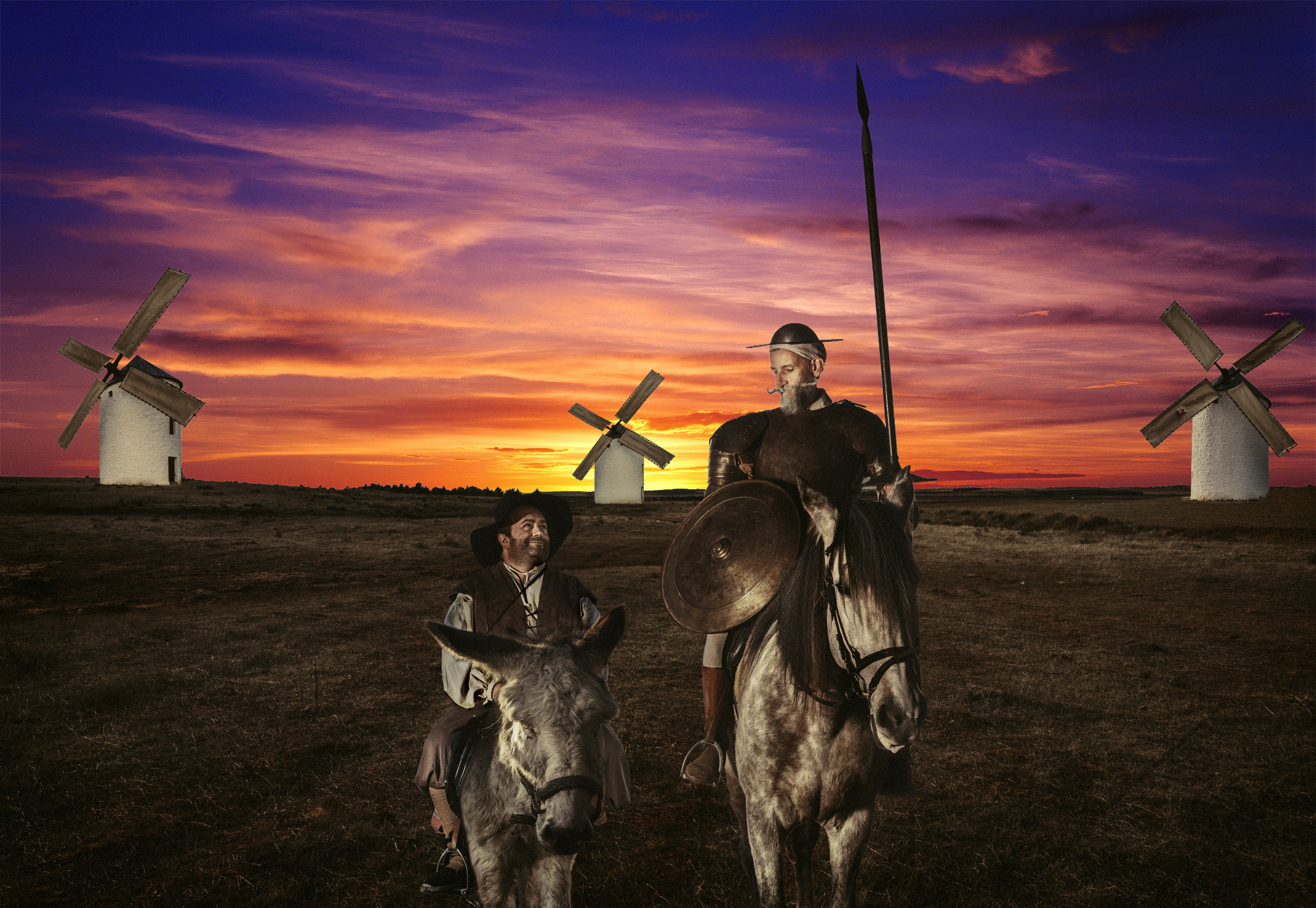
Written by DALE WASSERMAN
Music by MITCH LEIGH
Lyrics by JOE DARION
Original Production Directed by Albert Marre
MAN OF LA MANCHA is presented by arrangement with Concord Theatricals on behalf of Tams-Witmark LLC.
www.concordtheatricals.com
Conductor: Laura Bergquist
Director & Choreographer: Lawrence Edelson
Fight Director: Michelle Ladd
Projection and Lighting Design: Barry Steele
Costume Design: Glenn Avery Breed
Wig and Makeup Design: Sue Sittko-Schaefer
Audio Design and Mixing: Paul Bevan
CAST
CAPTAIN OF THE INQUISITION – Bradley Bickhardt
MEN OF THE INQUISITION - Marcus Lee, Blake Jennings
MIGUEL DE CERVANTES (DON QUIXOTE and ALONSO QUIJANA) – Zachary James
MANSERVANT (SANCHO PANZA) – Brian Yeakley
Roles taken by the prisoners:
GOVERNOR / INNKEEPER – Aidan Smerud
PACO (A MULETEER) / PADRE – Steven Ricks
ANSELMO (A MULETEER) / BARBER – Jeremiah Tyson
PEDRO (A MULETEER) – Titus Muzi
JUAN (A MULETEER) – De’Ron McDaniel
TENORIO (A MULETEER) – Bradley Bickhardt
JOSE (A MULETEER) – Blake Jennings
MARCO (A MULETEER) – Marcus Lee
ALDONZA – Kelly Glyptis
ANTONIA (ALONSO’S NIECE) – Lauren Cook
HOUSEKEEPER – Whitney Robinson
DUKE / DR. SANSON CARRASCO (ANTONIA’S FIANCEE) / KNIGHT OF THE MIRRORS – Joel Balzun
MARIA (THE INNKEEPER’S WIFE) – Jouelle Roberson
FERMINA – Laura Soto-Bayomi
ROCINANTE (DON QUIXOTE’S HORSE) – Blake Jennings
DAPPLE (SANCHO’S DONKEY) – Marcus Lee
PRISONERS - Naomi Brigell, Lisa Buhelos
ORCHESTRA
FLUTE/PICCOLO
Jessica Han, principal
CLARINET
Nuno Antunes, principal
BASSOON
Gilbert Dejean, principal
OBOE
David Kossoff, principal
TRUMPET
Terry Szor, principal
Wayne DuMaine
HORN
Paul Riggio, principal
Joey Demko
TROMBONE
Lisa Albrecht, principal
Kyle Turner
GUITAR
Joel Brown
Sten Isachsen
BASS
Brian Cassier, principal
PERCUSSION
David Coash, principal
TIMPANI
Chihiro Shibayama, principal
MAN OF LA MANCHA is set in the late 1500s, when Miguel de Cervantes is thrown into prison by the Spanish Inquisition. Having failed as a soldier and as a playwright, Cervantes was working as a tax collector—until he made the mistake of foreclosing on a church. Now Cervantes and his manservant face a group of fellow prisoners, who stage a mock trial before the inmate known as “The Governor.” Faced with the loss of all his possessions, including a tattered manuscript, Cervantes proposes that his defense will take the form of a play. He begins to spin the tale of Alonso Quijana, “a country squire...no longer young...bony, hollow faced...eyes that burn with the fire of inner vision.” Quijana, having read too many tales of heroic knights in the age of chivalry, declares he will become a knight-errant— Don Quixote de la Mancha—traveling the countryside righting all wrongs. Cervantes’ manservant takes on the role of Don Quixote’s faithful companion, Sancho Panza.
Quixote battles a “giant”—in reality, one of the many windmills that dot the landscape of the plains of La Mancha. He is defeated, retreating to a “castle”—really a roadside inn. The inn is populated by rough mule drivers (muleteers); the kitchen serving-wench, Aldonza, scorns their advances, making no secret of her low beginning and harsh life. (“I was spawned in a ditch by a mother who left me there....”)
Quixote sees the boisterous muleteers as fellow knights and believes the hard-edged Aldonza to be a beautiful noble lady, whom he calls “Dulcinea” (meaning “sweetness”). Aldonza is confused by this; no one has ever treated her with kindness.
Cervantes now takes the story to Quijana’s home, where his niece Antonia and her fiancé, Dr. Carrasco, along with the housekeeper and Quijana’s friend Padre Perez, worry about Quijana’s increasingly erratic behavior. Although they each declare they are “only thinking of him,” it’s clear that they are determined to put a stop to Quijana’s antics and bring him home.
While Quixote admires “Dulcinea” from afar, Aldonza confronts Sancho: she asks why he follows a madman like Quixote. Sancho replies that he simply likes Quixote; Aldonza, alone, wonders what Quixote could possibly see in a woman like her. Meanwhile, the muleteers jeer at Aldonza and her eccentric admirer.
A wandering barber arrives at the inn. Quixote believes the barber’s brass shaving basin to be a magical golden helmet that makes its wearer invulnerable and demands that the barber give it to him. Dr. Carrasco and the Padre witness this. Carrasco is certain that Quijana/Quixote is mad, while the Padre is not so sure.
The Innkeeper, whom Quixote believes to be the “Lord of the Castle,” agrees to dub Quixote a knight once he has spent a night holding vigil. As he meditates alone, Aldonza interrupts him. She cannot understand—why does he do these things? He replies that it is necessary to follow the quest—every knight’s mission.
When the lead muleteer abuses Aldonza, Quixote leaps to her defense, leading to a fight between Quixote (aided by Sancho and Aldonza) and the gang of muledrivers. Quixote is victorious and is dubbed a knight by the Innkeeper. Meanwhile, Quixote is unaware that the angry muleteers have abducted Aldonza in revenge.
When they return to the inn, Aldonza returns after having been beaten bloody by the muleteers. She expresses her frustration and rage at ever having believed in Quixote’s dreams.
The Knight of the Mirrors, whom Quixote sees as his mortal enemy, the Enchanter, enters and challenges Quixote to a duel. As they battle, Quixote is struck by his reflection in the Knight’s mirrored shield—he sees himself for the broken old man that he truly is. The Knight reveals himself to be Dr. Carrasco.
The guards interrupt the story to inform Cervantes that he will soon be taken to face the Inquisitors. He asks for enough time to conclude his story.
Alonso Quijana, no longer Don Quixote, lays in his bed at home, surrounded by his family. His spirit has been broken; he is dying. Fighting her way through his family, Aldonza comes to Quijana’s side. He does not recognize her and does not know her name. She pleads with him, saying that he once called her “Dulcinea,” and he begins to remember. She reminds him of the words of his quest—“to dream the impossible dream.” Quixote dies as the Padre prays over him, and Aldonza declares that she is now Dulcinea.
Cervantes’ story is finished: the prisoners give him his manuscript, as the guards return to remove him from the cell and bring him before the officials of the Inquisition. As Cervantes is lead out of the prison, the inmates join together, singing Quixote’s song of his impossible dream.
Synopsis by Rob Hartmann,
www.robhartmann.com
Imprisonment—Captivity of the Human Condition
Man of La Mancha’s prison setting is a constant reminder of human captivity—both literally and metaphorically. The theme of imprisonment permeates La Mancha: while Cervantes and his fellow inmates are quite literally imprisoned, the story of Don Quixote is filled with characters who are trapped by circumstance and viewpoint. Dr. Carrasco views Quijana/Quixote as suffering from a “prison of the mind,” while Cervantes describes Quixote’s madness as a liberation from a realistic, but often unbearable understanding of the hardships and suffering of man. Quixote’s idealistic visions serve as a catalyst which liberates Aldonza, Antonia, and others from their psychological prison. Quixote’s journey leaves the audience questioning what psychological “freedom” looks like. Cervantes’ fellow inmates are hasty to attack and steal from Cervantes when he first arrives. However, when Cervantes presents his defense in the form of a story about one man’s journey to hope and idealism, he guides the prisoners on a journey to their own psychological freedom. Cervantes shows them how hope and fantasy have the power to free their minds even though they are still physically imprisoned. At the beginning of the play, the musical element only exists in the world of Don Quixote, however, by the end of the play the other prisoners are singing “The Impossible Dream” to Cervantes as he is taken to trial. This concrete shift shows how both art and optimism can be instrumental in the quest for freedom of mind and spirit, even for those who are physically imprisoned.
Quixotism, Idealism, and Faith
Don Quixote is such an iconic literary figure, that his name has become synonymous with the ideas of chivalry and unrealistic idealism. So much so, in fact, that the adjective “quixotic” means impractical, idealistic, foolishly romantic, rash, chivalric, and unrealistic—all characteristics attributed to Don Quixote. Man of La Mancha was born out of a movement of experimental and political theatre in the 1960s. Often, politically radical individuals are challenged or written off for being irrational, overly idealistic, or impractical. Anything outside the scope of traditional ways of thinking is labeled quixotic. In this play, quixotism is an attribute celebrated as something that opens minds and hearts and challenges pervasive cynicism and despair. Quijana’s transformation into Quixote is catalyzed by his despair about the cruelty of human kind and his desire to right all the world’s wrongs. He is perceived as mad in part because of his utter selflessness. His actions, while often absurd and extravagant, are ultimately in the interest of serving others. One of his biggest gifts to others is attributing to them their best self. We see this most notably in his treatment of Aldonza as Dulcinea. Aldonza is forced to work as a waitress and prostitute, she is harassed constantly by muleteers who treat her as little more than an object available to their whims. Quixote, however, sees her as his beautiful lady, Dulcinea. Quixote shows Aldonza kindness, adoration, and respect—treatment she has never before experienced. When Aldonza chooses to accept Quixote and his idealized vision of her, she is set free from the oppressiveness of her position and able to find faith and hope in herself and others. Quixote’s unfaltering belief in the good of others and the importance of his idealistic fantasies is a powerful one. He creates purpose and meaning in his life by finding a way to right the wrongs he saw in the world. When Carrasco promises a cure for Quixote’s madness, the Padre says, “May it not be worse than the disease.” He knows that taking a man’s dream away from him can be devastating, or in this case, fatal. Ultimately, the death of Quixote’s dream causes his actual death. When the Padre sings, “To Each His Dulcinea,” his lyrics suggest that people need a dream, that in fact, it is healthier to have a dream to follow than to live life mired in realism, “And yet how lovely life would seem if every man could weave a dream to keep him from despair.”
The Power of Storytelling and Art
The prisoners in Man of La Mancha viciously attack Cervantes and his servant when they arrive. When the inmates try to steal their possessions, Cervantes wants to protect his precious manuscript at all costs. Cervantes attempts to gain respect and empathy from his fellow prisoners through the power of his storytelling. Alonso Quijana, the protagonist of Cervantes’ story, is a man disheartened by the world he lives in, trapped by feelings of despair and overwhelmed by human cruelty and suffering. He seeks solace and comfort in novels about chivalrous knights and heroic journeys. Quijana is so moved by the stories he reads, that he changes his entire identity to mirror the knights he so greatly admires. Quijana, transformed into Quixote, believes that by living out these stories, he can effect change in the world. Quixote creates meaning for himself and for others whom he enlists on his hero’s journey. Ultimately, by allowing himself to be so moved by these stories, he positively changes his own life, as well as the lives of the people he meets along the way. Cervantes’ story is so powerful that not only do his fellow prisoners agree to return his belongings to him by the end of the play, but they also all begin to sing “The Impossible Dream” as Cervantes and his servant are marched to their trials. The prisoners are moved to empathize with Cervantes and his servant and they too begin to accept Quixote’s idealism and believe in the impossible. The inmates are encouraged to dream, allow themselves to be moved, and treat one another with kindness. Just like Quixote effects positive change through enacting his own story-life, Cervantes effects positive change by sharing that story in the form of a play.
Additional information generously provided by A Noise Within: anoisewithin.org
DON QUIXOTE (El Ingenioso hidalgo Don Quijote de la Mancha) was first published in Madrid in 1605 when Cervantes was 57. The book was an immediate best-seller, but despite its success, Cervantes received very little money from the book as he had sold the rights to his publisher. Six editions were printed in the first year of its release. Part II was published in 1615. A single edition containing both parts was published in 1617.It is considered to be one of the greatest works of fiction ever written and is the most published and translated book after the Bible. Seven years after the first part appeared, it was translated into French, German, Italian and English. It was subsequently translated into English more than 19 times, and several abridged versions appear. Don Quixote is a humorous novel filled with satire: the first half of the novel is farcical, the second half serious and philosophical. Its picaresque style characterized it as a landmark work of literature. The novel’s widespread influence helped cement the modern Spanish language. Don Quixote successfully straddled the two modes of literature popular at the time: the medieval chivalric romance and the modern novel. The character of Don Quixote was so popular that the word quixotic meaning “extravagantly chivalrous or romantic, visionary, impractical, impulsive and rashly unpredictable” (Dictionary.com) was incorporated into many languages.
Additional information generously provided by A Noise Within: anoisewithin.org
Man of La Mancha
Man of La Mancha was perhaps the first true “concept musical,” the kind of musical in which the over-arching metaphor or statement is more important than the actual narrative, in which the method of storytelling is more important than the story.
The roots of Wasserman’s Man of La Mancha lay in the Golden Age of Television for CBS’s Dupont Show of the Month program. Originally produced as anon-musical television play I, Don Quixote, starred Lee J. Cobb as Cervantes, Colleen Dewhurst as Aldonza and Eli Wallach as Sancho Panza. Upon its telecast, the play was well received by both the public and the critics alike and Wasserman received an award from the Writers Guild of America.
The television play was then adapted for the stage. Albert Marre, who was directing the stage production, asked Wasserman to turn it into a musical. Mitch Leigh was selected as composer and the original lyricist was W.H. Auden. Auden wrote great poetry but not great lyrics and he was writing a different, more cynical show. Consequently, he was replaced by Joe Darion, of Shinbone Alley fame, who stepped in and wrote the lyrics for the musical which we know and love today.
I, Don Quixote has an almost identical plot to what would become Man of La Mancha. The opening lines to the most famous song in the show, “The Impossible Dream”, were written by Wasserman as part of a monologue. In the musical, the character of Cervantes proposes to improvise the story of Don Quixote inside the prison and invites the other prisoners to take part. In the play, Cervantes describes the character of Don Quixote and the play segues into the story of the knight. The play also includes many adventurous episodes from the novel which were omitted from the musical due to time constraints.
Man of La Mancha was born out of the experimental theatre movement of 1960s New York, and was written to be played in a small theatre. Its original New York production was staged in three-quarter thrust, with the audience on three sides of the stage. Just as Cervantes’ novel rarely provides much detail of the settings of Quixote’s adventures, leaving it up to the reader’s imagination, likewise the musical’s creators wanted their show to be extremely minimalist, with a bare set, minimal costumes and props, and the challenge to its audience to participate in the storytelling through the use of their own imagination. But it asks for us to participate in another way as well. In its heart, Man of La Mancha is about the 1960s, and by extension, about any time of political unrest—including today—and it is about the responsibility of each of us to make the world a better place than we found it.
Man of La Mancha is not a musicalization of Don Quixote; it is instead a show about a few hours in the life of Miguel de Cervantes, using Quixote as a storytelling device. As the show’s bookwriter Dale Wasserman has written, “My man of La Mancha is not Don Quixote; he is Miguel de Cervantes.” In fact, only a tiny part of the novel is dramatized in the show; after all, there are more than four hundred characters in the novel. When Wasserman originally set out to write the first, non-musical version of his play, he remembers, “In theory the answer seemed simple. I’d write a play about Miguel de Cervantes in which his creation, Don Quixote, would be played by Cervantes himself. The two would progressively blend in spirit until the creator and his creation would be understood as one and the same.”
Man of La Mancha first opened at the Goodspeed Opera House in 1964. Rex Harrison was to be the star of this production, but when he found out that he actually had to sing the songs, he lost interest. Michael Redgrave was also a candidate for the role of Cervantes / Don Quixote.On November 22, 1965, the musical opened at the ANTA Theatre off Broadway, downtown near Washington Square Park in Greenwich Village. It was the perfect place for it, sharing more in common with radical, anti-establishment works like Marat/Sade and Wasaserman’s own One Flew Over the Cuckoo’s Nest, than with Hello, Dolly! or The Sound of Music. The ANTA had no fly space, no proscenium arch, no curtain, none of the trappings of traditional theatres. But by some weird quirk of contract law, the ANTA was officially categorized as a Broadway house because of its seating capacity, despite being some forty blocks from the rest of Broadway, and only a few blocks from other off Broadway houses. So, as it would all its strange life, Man of La Mancha was born straddling the experimental world of off Broadway and the commercial world of Broadway. Life magazine called the show “a metaphysical smasheroo.” The New York Post said, “Man of La Mancha is a triumph of creative imagination and stagecraft.” London’s Morning Telegraph said, “Man of La Mancha is what theatre is for, why theatre lives and endures.” Rolling Stone wrote, “Man of La Mancha has a heart that sings and a spirit that soars.” John Chapman of the New York Daily News called the original production, “an exquisite musical play—the finest and most original work in our musical theatre since Fiddler on the Roof opened. It moves enthrallingly from an imaginative beginning to a heart-wrenching end.” Norman Nadel wrote in the World-Telegram & Sun, “To reach the unreachable star—what a soaring aspiration for an indestructible dreamer, and what a glorious summation for a bold and beautiful new musical.” He went on, “Thus it goes all evening—realism aligned with romanticism, and each sharpened by the other.”
The show starred Richard Kiley as Quixote and Joan Diener as Aldonza, and it won the Drama Critics Circle Award, the Outer Critics Circle Award, the Variety Drama Critics Award, the Saturday Review Award, and five Tony Awards, including best musical and best score. The show moved uptown in March 1968 to a regular Broadway house, the Martin Beck Theatre, then, oddly, moved in March 1971 to the off Broadway Eden Theatre, then again in May 1971 to the Mark Hellinger Theatre back on Broadway. It ran a total of 2,328 performances and was revived in 1972 (less than a year after the first production closed), and again with Kiley in 1977. The world famous French/Belgian songwriter and singer Jacques Brel saw the show in New York and fell in love with it. He brought it to Paris, playing the lead himself. Luckily, a French cast album was made, preserving Brel’s soulful interpretation. Productions of La Mancha were mounted all over the world, and in September 1972, it even opened in the Soviet Union. The show was revived again in 1992 with Raul Julia and Sheena Easton, then again in 2003 with the African America actor Brian Stokes Mitchell as Quixote. Today, the show enjoys 300-400 productions each year.
When the play was made into a film in 1972, Peter O’Toole played Cervantes / Quixote. Everyone else in the cast with the exception of O’Toole, who was dubbed by Simon Gilbert, sang their own songs. Some material from the original television play, which was omitted from the stage musical, was included in the film version.
The Spanish Inquisition
Miguel de Cervantes was tried by the Spanish Inquisition in 1597, and was excommunicated for “offenses against His Majesty’s Most Catholic Church,” escaping more severe punishment, which could’ve included burning at the stake. He served several prison terms.
In 1478 Ferdinand and Isabella established the Spanish Inquisition. Quite separate from the Medieval Inquisition instituted by Pope Innocent III, the Spanish Inquisition was controlled by Ferdinand. The Spanish Inquisition was used as a cloak for grand larceny as well as political and private revenge, and the inquisitors were known for their fanatical zeal and great cruelties. The church and state were united closely (mostly for the profit of the state), and heresy was considered a crime against both, to be compared only with high treason and anarchy.
At the time of Ferdinand and Isabella, Spain was a mixture of Christian, Jewish and Muslim cultures that had generally lived a peaceful co-existence. Granada in the south was very Moorish and the cities of Seville and Barcelona had large Jewish populations. The Jews were very loyal subjects and occupied many important religious and political quotes. The kingdom of Castile even had an unofficial rabbi.
However, towards the end of the 14th century there was a growing feeling of anti-semitism. In Seville hundreds of Jews were killed and the synagogue was completely destroyed. Similar incidences happened in the cities of Cordoba, Valencia and Barcelona. Following this there was a huge conversion of Jews leading to a new social group in the 15th century: New Christians or conversos. By going through the long and difficult process of converting, Jews could escape persecution and hold many offices and posts that were earlier closed to them. Conversos were not trusted by either Jews or Christians.
Jews who continued to practice their faith were not a direct object of persecution; however, they were a target of suspicion because it was thought that they influenced conversos to return to their former faith. On March 31st of 1492 a decree was issued that all Jews had to accept baptism into the Catholic faith or leave the country by July 31st. They were allowed to take all their possessions with them, but were forced to sell their land. Gold, silver and coined money were forfeited to the Inquisition. It is thought that of a population of 80,000 Jews, about one-half of them chose emigration. The most intense period of persecution of conversos lasted through 1530. With the reign of King Charles I in 1516, conversos were hopeful of an end to the Inquisition; however, the new king left the system in place.
During the 16th century, most trials were focused on the beginnings of Protestantism. The first trials directed at Protestants were against a sect of mystics or Alumbradosin Guadalajara and Valladolid. None were executed, but the trials were long and ended with prison sentences. The subject of the Alumbrados opened up the Inquisition to many intellectuals and clerics interested in the ideas of Erasmus. Ironically both Charles I and Philip II of Spain were admirers of this philosopher and theologian.The third group to suffer under the Inquisition were moriscos, or Muslims who had converted from Islam. The highest population of moriscos lived in the areas of Granada and Valencia. Officially, all Muslims in Castile had converted to Christianity in 1502. Those in Aragón and Valencia were forced to convert in 1526. Many moriscos maintained their religion in secret. Initial policy toward them was more of a peaceful evangelization than intense persecution. In the kingdoms of Valencia and Aragon, a large majority of moriscos were under the jurisdiction of the nobility and persecution would have been viewed as an assault on the economic interests of this social class.
The Inquisition judges, aided by local bishops and state authorities, would come to a town and announce a grace period, the Edict of Grace, for all heretics to come in and confess their crimes and be punished, after which the trials began. All the self-incriminated who presented themselves within a period of grace of one month were offered the possibility of reconciliation with the Church without severe punishment. Self-incrimination was not in and of itself the saving grace for many people, one also had to accuse all accomplices.
Every Catholic citizen was charged with the responsibility to report suspicious behavior. Accusers were anonymous—the defendant had no way of knowing who had accused him. False denunciations were common resulting from personal vendettas. The names of witnesses were kept secret.
Following a denunciation, the case was examined by calificadores, followed by detention. Many people were detained for long periods of time (sometimes up to two years) before their case was heard. Property of the accused was immediately sequestered by the Inquisition. The property was used to pay for procedural expenses as well as the accused’s maintenance and costs. This often subjected the relatives of the defendant to poverty.
Torture was often used to force confessions of guilt. At public ceremonies, the names of the guilty were announced and punishments inflicted, ranging from fines and excommunication to imprisonment for life or burning at the stake, called “purification.” The most popular methods of torture by the Inquisition were garrucha, toca and the potro. The garrucha consisted of hanging the criminal from the ceiling by a pulley with weights tied to the ankles, with a series of lifts and drops during which arms and legs were pulled and often dislocated. The toca forced a cloth into the mouth of the victim forcing them to drink water spilled from a jar so that they had the impression of drowning. The potro, or the rack, was the most popular instrument of torture. When the victim confessed, the torture was ended.
Minor infractions were punished by having to wear the sanbenito, a gown on which was painted a sign of the crime committed. Other potential results of trial were acquittal, suspension, a public penance (consisting of a fine, exile or sentence to the galleys), a public ceremony of reconciliation, a long period in jail or public whipping. The most serious punishment was burning at the stake in a public execution. If repentant, the body was garroted before being burned, if not the individual was burned alive. If the accused died prior to the completion of trial, their body would be burned in effigy.
The Inquisition was abolished during the Napoleonic Empire (1808—1812) but was reinstituted when Ferdinand VII recovered the throne in 1814. The Inquisition was finally abolished in 1834 by Royal Decree during the reign of Isabel II. The total number processed by the Inquisition was approximately 150,000. Between 3,000 and 5,000 were put to death.
Additional information generously provided by A Noise Within: anoisewithin.org








